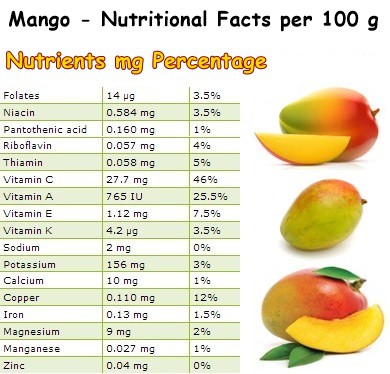Originating in India, mango (Mangifera indica) is one of the most appreciated tropical fruits in the world. There are over 1000 mango cultivars grown throughout the tropical world, all of which posses valuable curative properties. Ripe mangoes are a great source of vitamins C and A as well as copper, three powerful antioxidants and anti aging nutrients.
Moreover, the fruit contains small amounts of important B vitamins such as thiamine, niacin and folate. What is interesting is that unripe mangoes have twice as much vitamin C than ripe ones, adding to the health benefits.
What does mango look like?
Mangoes (or mangos) are reniform or kidney-shaped fruit with a hard skin. All unripe mangoes are green. However, different varieties take on different skin colors as the fruit matures. Ripe mangoes can thus be red, yellow or orange or even have patches of yellow-green or red-green. Knowing how each variety should look is the key to identifying ripe mango.

What does mango taste like?
Unripe mango has a hard flesh and a sour taste. Ripe mango generally has a sweet, extremely fragrant, juicy golden-yellow pulp. It has faint minty flavors, yet is pleasantly sweet and refreshing overall. Some mangoes are also slightly acidic, reminiscent of lemons, but the flavor is not overpowering at all. The pulp of the fruit can be firm or soft, fine or fibrous. The larger the fruit variety, the more fibrous its pulp.
The smaller the variety, the softer the pulp. The fruit has one large brown seed in the middle, which is often quite difficult to remove without no pulp. The skin is not edible and is thus discarded by peeling. If mango is ripe, you can scoop the pulp with a spoon.
How to pick good mango
The first step is being able to identify what mango variety you are up against so you can get an idea of how the ripe fruit should look like. A quick internet search will reveal whether or not the yellow mango you are about to purchase is fully ripe. Secondly, you need to test the firmness of the fruit. Ripe mango should be soft, yet ripe. It might be best to avoid bruised or mushy fruit which might be overripe. The third and probably most important step is the test smell: take the mango in your hand and give it a sniff. If it smells sweet and reminds you of the fruit, then it’s good. If it smells like a spoilt fruit, then it’s most likely spoilt.

What are the benefits of eating mango?
Regular consumption of mango can provide the following 6 health benefits:
Alkaline food
After digestion, mangoes leave an alkaline trace in our body, thus positively influencing our blood pH. While acidic foods such as meat or dairy products increase our risks of getting ill, alkaline foods promote detoxification, support natural cell repair processes, increase our body’s ability to absorb nutrients and significantly reduce illness factors. Mangoes are among the most potent alkaline foods.
Immune-boosting benefits
Eating mango helps prevent scurvy and stimulate immunity as a result of a high vitamin C content (46% of the RDA). Having enough vitamin C in your diet is crucial for the prevention of scurvy, an illness causing gum disease, teeth loss, lethargy, poor wound healing, shortness of breath, edema and ultimately death. Vitamin C-rich foods such as mango boost immunity, increasing resistance to infections, promote faster wound healing, help treat common cold symptoms such as stuffy nose, muscle pain and inflammation and promote artery health.
Benefits for eyesight
Mango provides 25.5% of the RDA of vitamin A and thus helps improve night vision and eyesight in general. Moreover, it maintains healthy mucous membranes at the level of the eyes, nose, mouth, throat, lungs and digestive system and therefore reinforces our body’s first line of defense against bacteria and viruses.

Anti aging benefits
Mango is a good source of vitamins A, C and E, three powerful antioxidants which lend skin its firmness, elasticity, radiance and overall youthful appearance. Moreover, it contains good amounts of copper, a mineral said to delay aging signs such as gray hair and iris discoloration.
Rich in antioxidants
The pulp of the mango fruit is a rich source of carotenoids, particularly beta-carotene, hence the golden color of the pulp. Beta-carotene is a potent antioxidant with provitamin A activity, meaning that a part of it is converted into vitamin A and thus contributes to retina health, reducing the risks of age-related vision loss.
Both the pulp and the skin contain dozens of other carotenoids and polyphenols which combat free radical damage and promote cell health. Nevertheless, it might be best to avoid mango skin, sap and stem oils because they contain allergens which may cause rashes or serious allergic reactions.
Other benefits
Mango has mild laxative, diuretic, tonic and astringent properties. Mango juice, for instance, makes a wonderful tonic because it concentrates more vitamins and minerals. Some studies suggest that mango strengthens the heart muscle and stimulates appetite as well. If consumed in small amounts, preferably not every single day and paired with foods containing plenty of fiber, protein and some fat, mango can be eaten safely with diabetes too. Also see can you eat mango with diabetes?
Conclusion
Overall, mango is a nutritious and delicious fruit, with a moderate calorie content of only 60 kcal/100 g of fresh pulp. Its tropical fragrance makes it quite hard to resist. Both slightly unripe and ripe mango are healthy, the difference between the two being that unripe mango has a significantly higher vitamin C content, hence its sourness. Nevertheless, unripe, green mangoes should be consumed with moderation because an exaggerated intake may cause throat irritation due to acid reflux and digestive problems such as loose stools and diarrhea or painful abdominal cramps.
